How to start an agency according to 8 successful founders
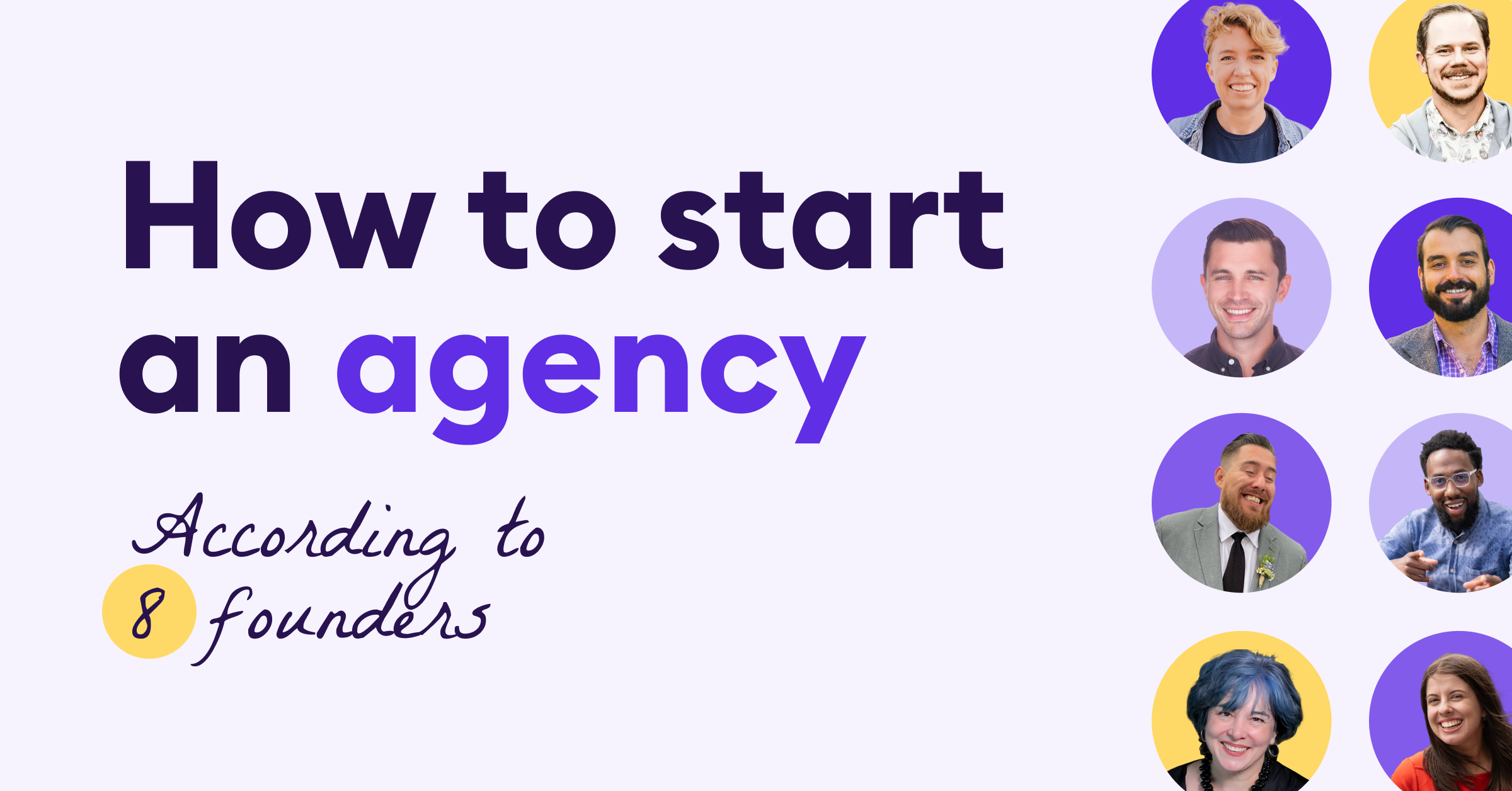
So you want to start an agency? You’re not alone. More people than ever are leaving their traditional jobs to build something of their own. There are 101,316 advertising agencies in the U.S., up 4.5% since last year.
Now is the moment for it. It’s easier than ever to start an agency compared to other business types—you often only need a laptop and internet to launch. At the same time, large companies are increasingly willing to hire these new agencies because it’s harder to fill full-time roles. Often, a new agency's first client is the founder's previous employer.
Pilot works with hundreds of agencies, and in this guide, our operations and CFO Services teams share a full roadmap for how to start yours. You’ll learn to choose your niche, price your services, register your business, and hire. We also share firsthand insights from eight successful agency owners on what they’ve learned, including some who’ve been at it for 20 years.
Inside this guide:
- Save up runway
- Choose a niche
- Set competitive rates
- Register your agency
- Build a simple website
- Start cold outreach
- Build your founder brand
- Create operating procedures early
- Hire slowly
- Get fractional finance and operations help
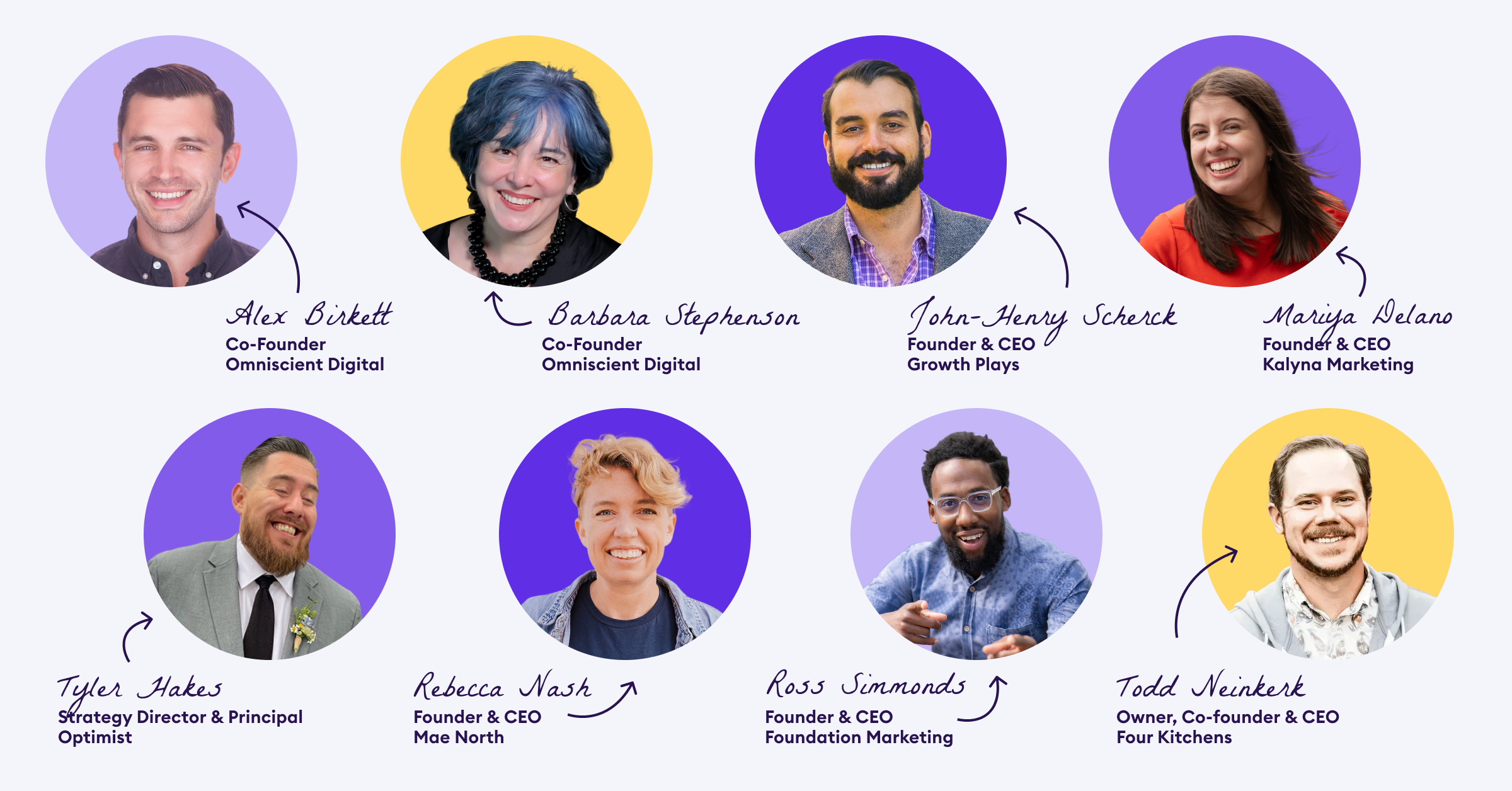
Step 1: Save up at least 3 months of runway
Growth is often both faster and slower than you expect. You might land your first client quickly, then go months without another. As Bill Gates once said, “Most people overestimate what they can do in one year and underestimate what they can do in ten.”
Early traction can be misleading. It takes time to build a reputation, earn referrals, or set up a system for getting clients consistently. Without enough financial runway, you risk running out of cash just before opportunities start coming in.


That’s why the very first thing to do before launching is to have enough cash to cover both your personal and business bills, like internet, software subscriptions, marketing expenses, etc., for three months.
Without this financial cushion, you’re more likely to make poor decisions out of desperation, like allowing scope creep, agreeing to unreasonable deadlines, or taking on low-paying clients. But with a runway, you can say no to bad-fit clients and hold out for better-paying work.
You can build this runway by saving from your full-time job or keeping a side hustle until you have enough cash.
To calculate how much runway you have, use Pilot’s Burn Rate Calculator. Just enter your cash balance at the end of the last three months (or up to 12 months for more accuracy). The tool will automatically show:
- Your average monthly burn rate
- How many months of runway you have left
- How your burn rate and runway have changed over time
- A simple graph showing the progression of the cash balance
Or you can use this formula:
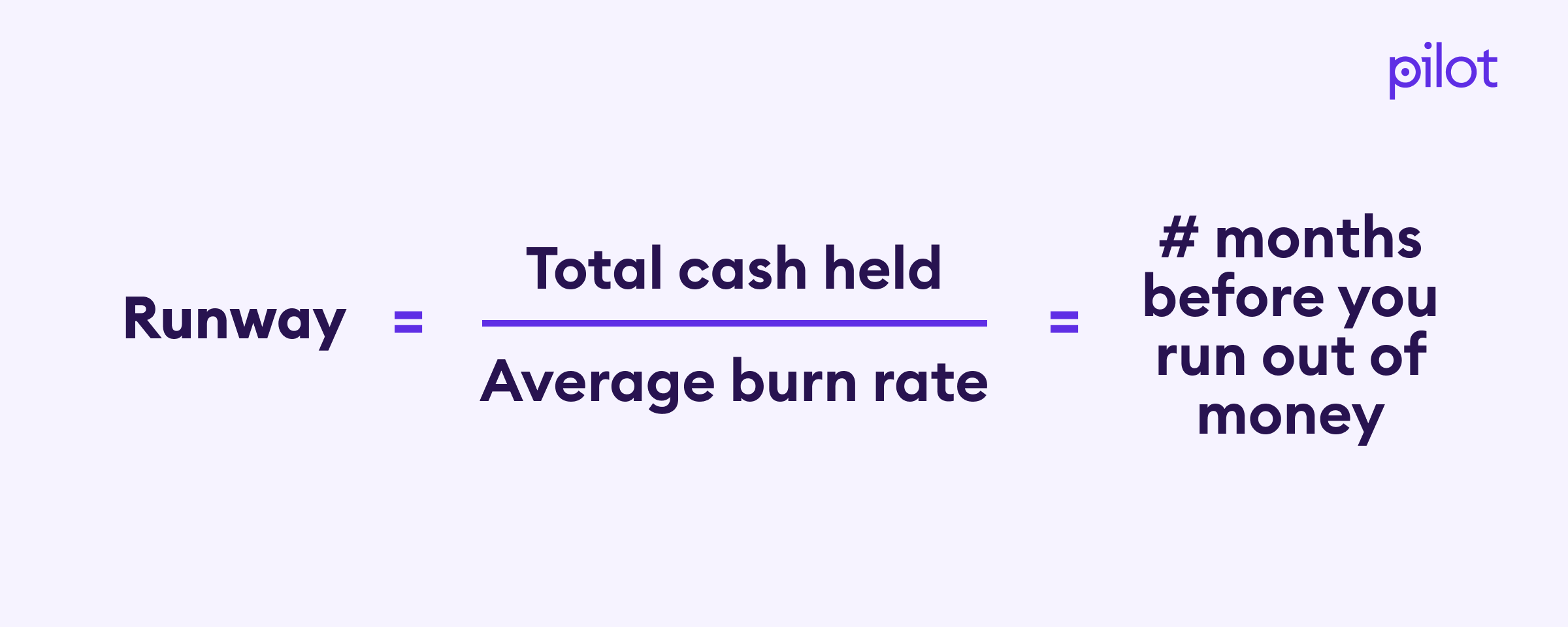
Let’s say you saved $50,000 before quitting your job and your monthly expenses are $4,000 personal living costs and $1,000 business costs. That’s $5,000 in costs per month, and using the formula:
Runway = $50,000 ÷ $5,000 = 10 months
So you’d have ten months to build a system for getting clients.
Note: To stretch your runway even further, reduce your expenses where you can. See if you can substitute certain software for cheaper ones or use free versions of tools until you need paid upgrades.
Step 2: Choose a niche
One of the most common mistakes new agencies make is trying to serve everyone. It’s understandable—you want revenue quickly, and turning away potential clients feels wrong. So you keep your positioning broad and avoid defining who you serve or what you offer in the hopes that you will get more leads.
But ironically, the broader you go, the harder it is to stand out and win qualified clients. Companies today are increasingly prioritizing specialists over generalists because they’re under pressure to justify every dollar spent due to the slowing U.S. economy and tighter budgets. So they want to hire people who deeply understand their industry or problem and can deliver results fast.
Without a clear niche, it’s harder to market your agency, build a reputation, or scale sustainably. You end up competing with much larger agencies, but don’t have a unique selling proposition that will compel them to choose you.
“Being an expert in one area allows you to be the go-to person. When you are known for something specific, it’s easier to get referrals, build expertise, and grow a personal brand. It’s hard to be known for doing everything,” says John-Henry Scherck, founder and CEO of Growth Plays.
That’s why niching down matters. Going deep in one specialty acts as a filter—it might turn away some clients, but it will attract the right ones, i.e, the ones who understand your value, respect your process, and are willing to pay for your expertise.
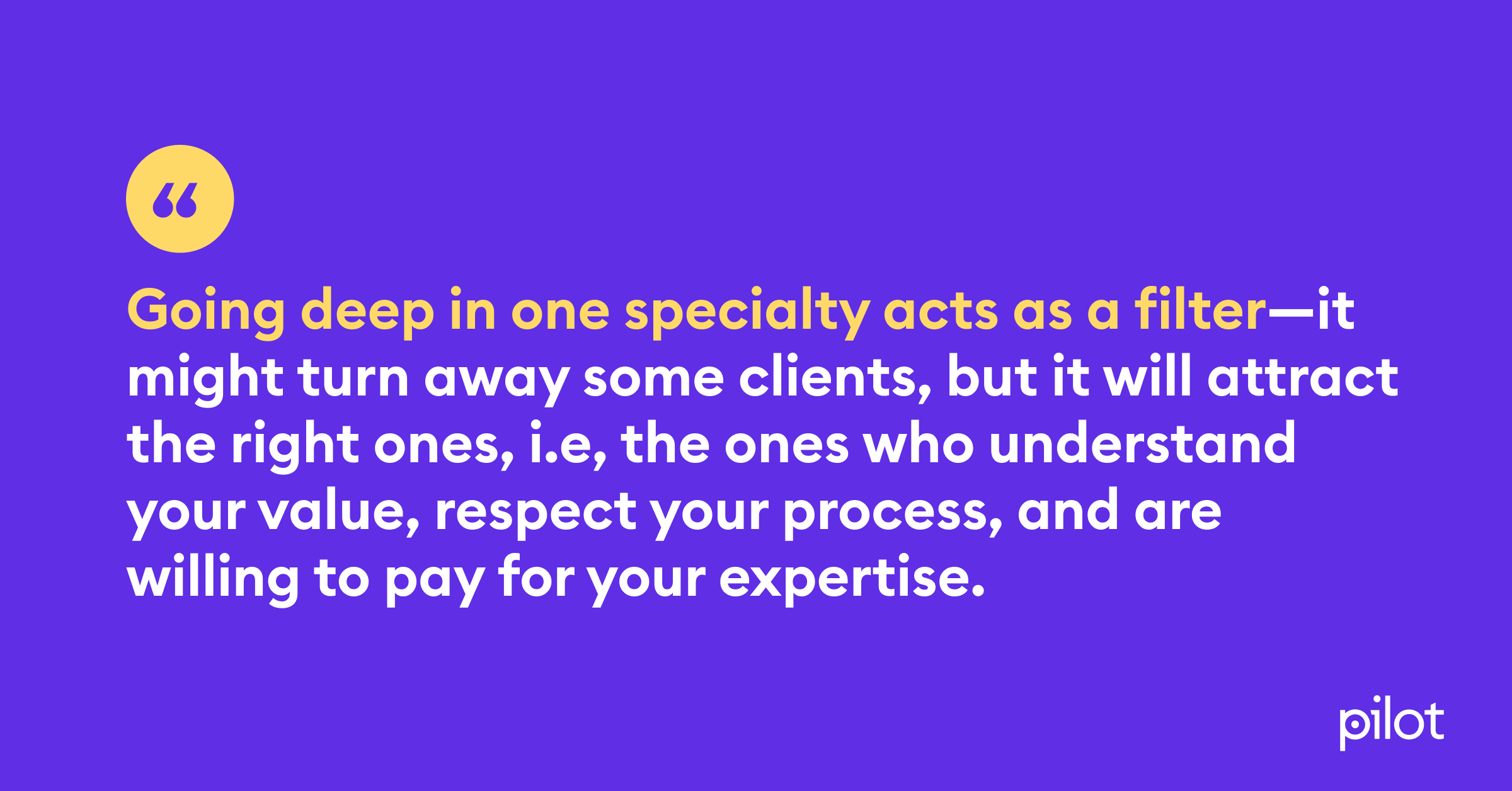
To choose your niche, start with your strengths
Make a list of the services you’re best at, industries you know well from past jobs, clients, or personal experience, and projects where you’ve delivered great work. Look for overlap in your answers. For example, if you’ve delivered great SEO results for SaaS companies, that’s a potential niche.

Next, review past clients and projects for the type of clients you enjoyed working with and why, who paid well and on time, and where you got the best results. Use the answers from this step and the previous one to generate a short list of potential niches.
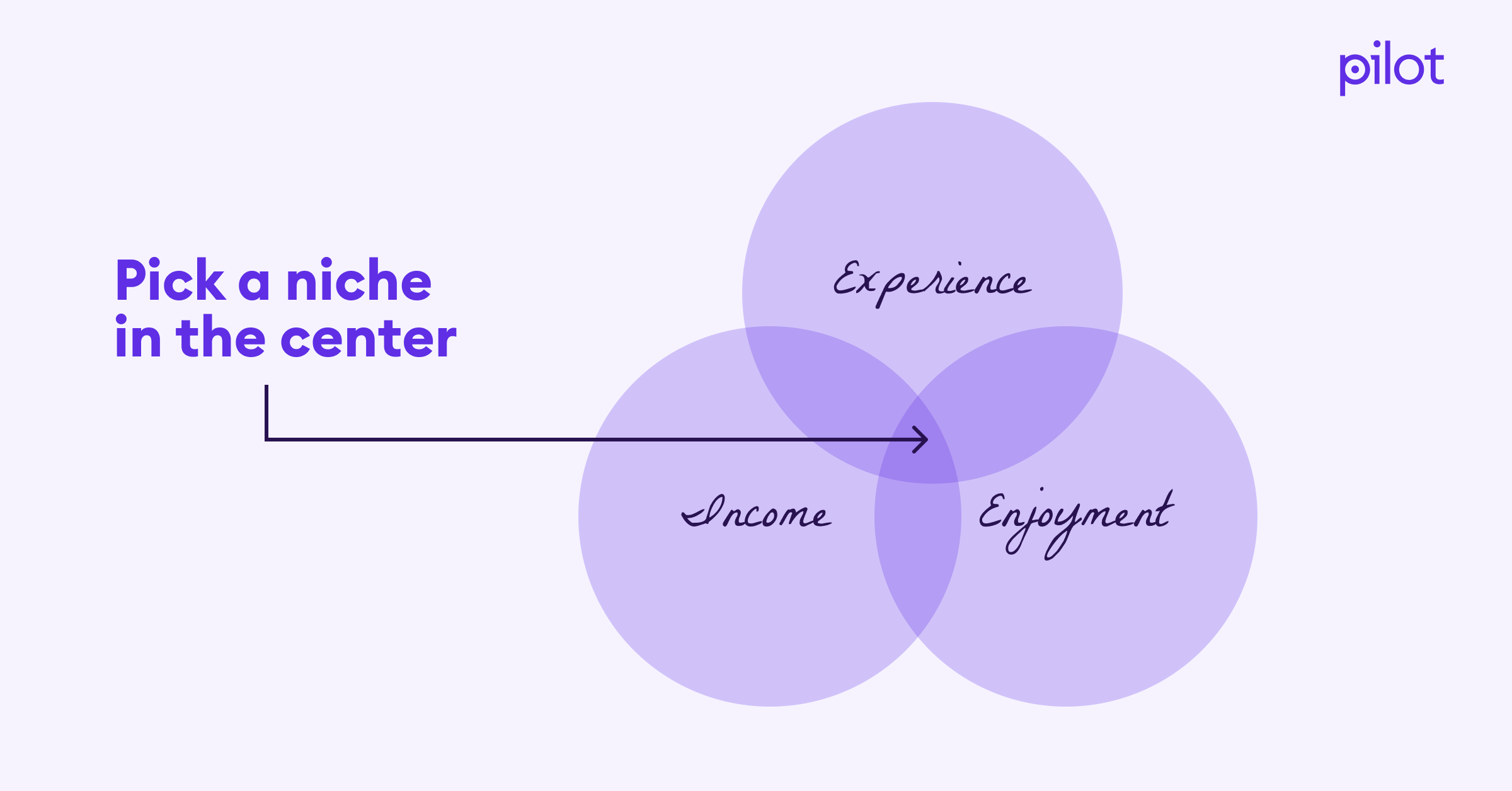
Now check the market demand for your services within the niche on your list. Use:
- Google Trends to see long-term demand
- Ahrefs/Semrush to explore search volume for specific services
- LinkedIn job posts or freelance marketplaces to gauge hiring activity
Cross out niches with little demand, pick your top 2-3, then test those companies’ spending power and willingness to pay by researching what other agencies charge, and talking to other agency owners and prospects directly.
Choose the niche that checks all the boxes: strengths, demand, and budget, and stick with it for several months. If you don’t see traction, adjust and repeat the process. For instance, if you decide to niche down as a paid ads agency for veterinary hospitals, say:
“We help veterinarians book more appointments with Google Ads that convert.”
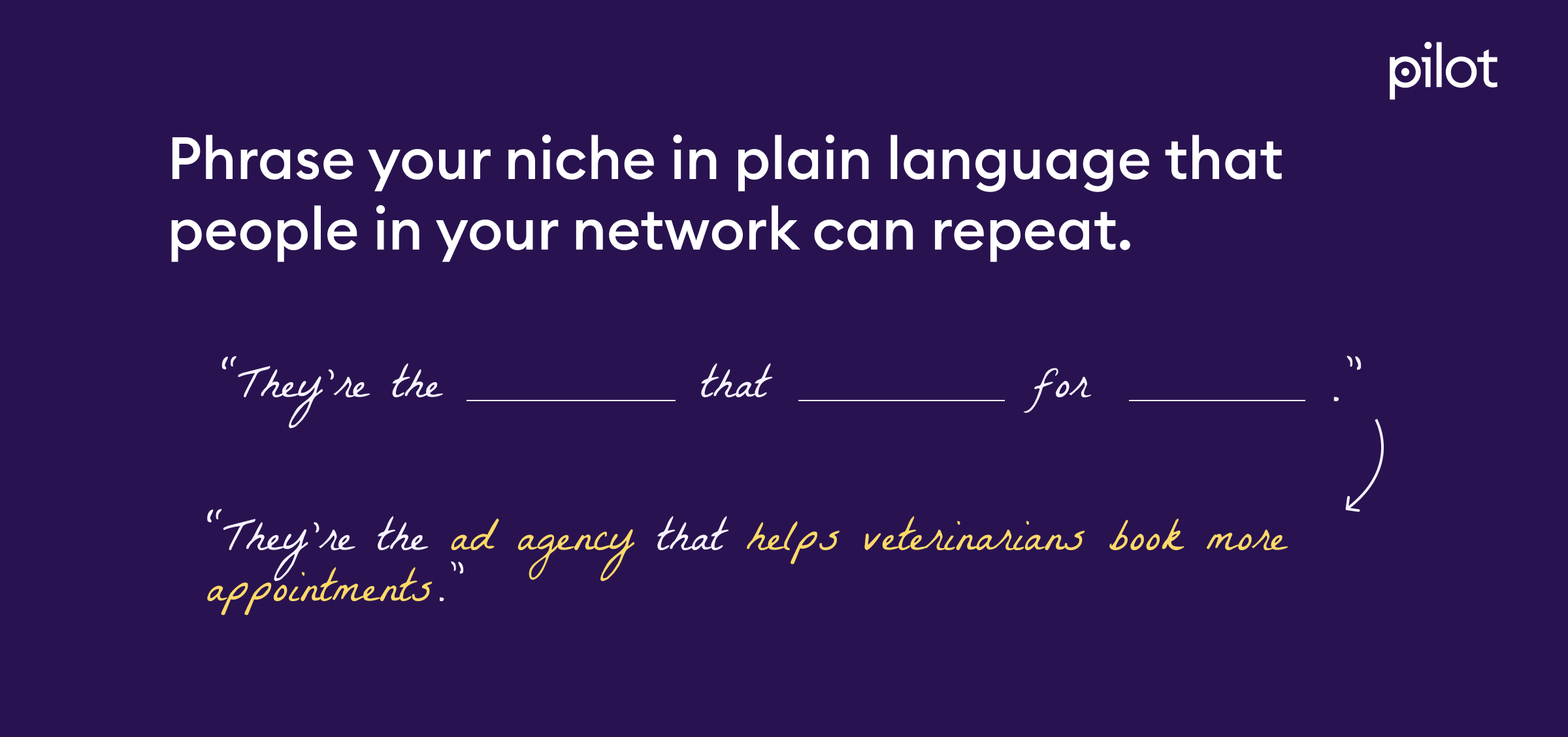
Then update that positioning on your agency’s website, LinkedIn, cold pitches, etc. The goal is for someone in that niche to instantly think, “Oh, they specialize in exactly what I need.”
Note: Use language your audience actually identifies with in your positioning. Otherwise, it won’t resonate with them and they won’t reach out.
For example, when the web agency Four Kitchens rebranded around serving “mission-driven organizations,” that message actually didn’t appeal to their largest client group: higher ed.
“We thought we were speaking to both nonprofits and universities with that phrase,” says co-founder Todd Nienkerk. “But higher ed doesn’t identify with that phrase at all.”
So Four Kitchens revised their messaging to speak directly to higher ed. Now, their homepage reads: “AI, content management & web platforms for higher ed.”
![A screenshot of the agency four kitchen’s website]](https://cdn.prod.website-files.com/60a6b551be6130e4e5b19b98/68e8fe48624b0800282cffc2_SCR-20250923-ehwy.png)
Step 3: Set competitive rates
One of the most important decisions you’ll learn to make is pricing your services. Set too low a price and you won’t be profitable and you’ll attract bad-fit clients who undervalue your work. But price too high before you have allies and social proof and you’ll scare away prospects.
To land on the right pricing, add up your baseline expenses: software, contractors, admin, your own salary, and your net profit margin (most agencies operate at 11-20% profit margin according to HubSpot).
Choose a pricing model
Agencies typically use a mixture of the following
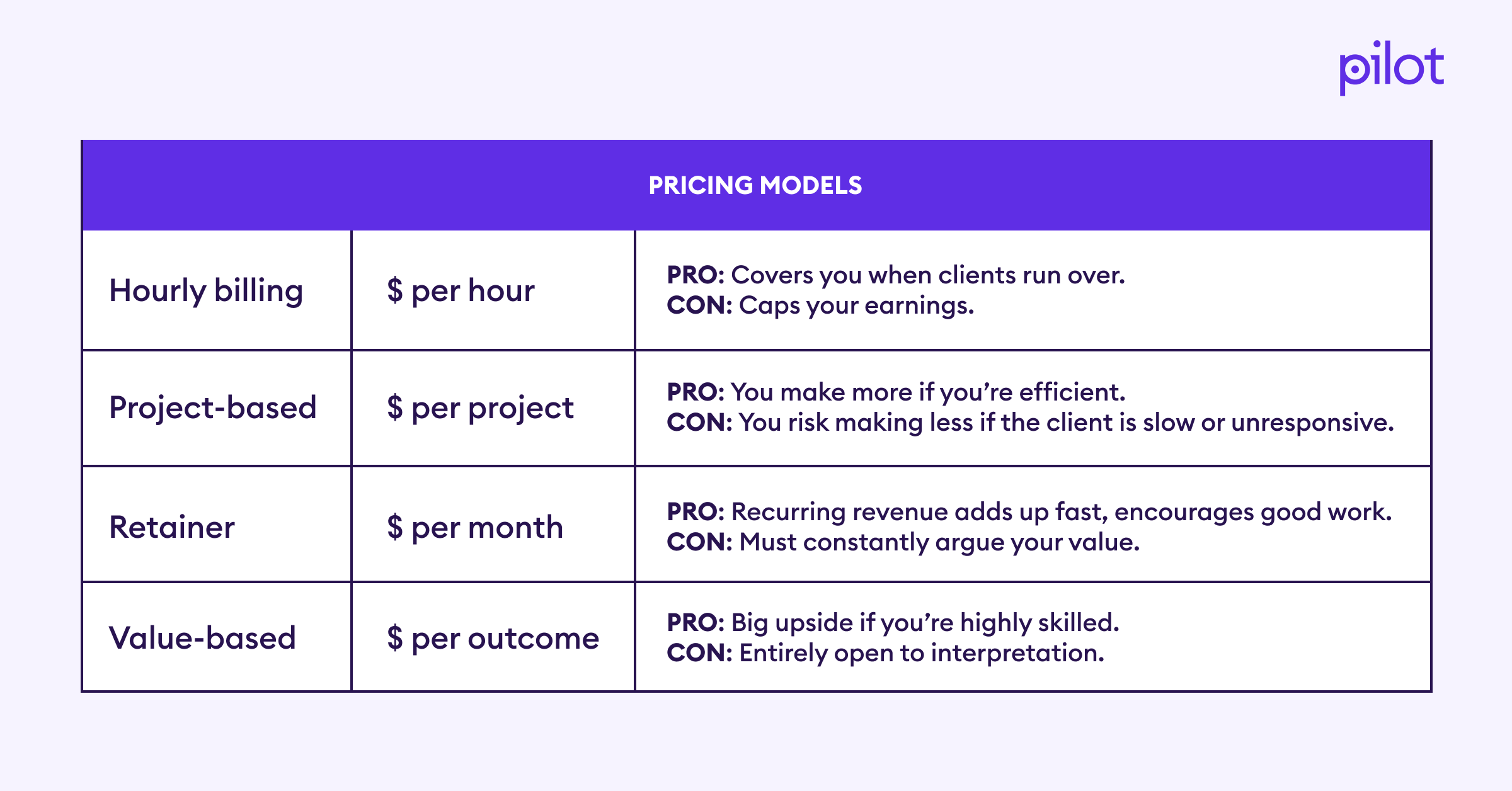
Out of all these, try to graduate from using hourly billing as your primary pricing. It caps your earnings, makes clients focus on your time instead of your results, and positions you more like a freelancer than a strategic partner. Instead, start with project-based pricing. It’s easier to sell a clear deliverable at a fixed fee, especially when you’re just starting out, and it helps you build your portfolio.
Once you’ve gotten results, you can then start charging clients on retainers and subscriptions. And then charge based on value for services where you can measure return on investment.
Note: Pricing is dynamic. It’ll change as your agency grows, but you need a good baseline to scale. A simple rule of thumb: Raise your rates with each new client until you start hearing “No,” then adjust.
Choose your packaging
There’s pricing, and then there’s packaging—deciding what options to offer. Give clients the above menu and they might hire you for 15 minutes. Or buy the wrong thing. Create packages that are neatly aligned with solving the problem your client actually wants to solve. Because there is the reason they hired you—say, to write articles. And there’s the unstated reason—they need traffic to attract leads.
You really can’t go wrong with “three-pronged pricing.” Sell packages, learn, adjust, and improve.

Step 4: Register your agency
As soon as possible, make your agency official and register it by filing to create a business entity. That entity gives you the ability to register for an Employer Identification Number (EIN), the business version of a Social Security number. This gives you credibility, allows you to open a business bank account, protects you from anything your agency does wrong, and makes hiring and tax filing much simpler.
First, check that the name is available
Check that your desired name is available both at the federal and state level. If you’re using a brand name (not your personal name), file a DBA (“Doing Business As”).
Just because someone has taken your name doesn’t mean you can’t have it—if they are in a different industry, it’s no problem. If it’s an adjacent industry, the patent office may allow them to challenge your name choice.
Consider outsourcing this to an operations professional who knows all the searches to run and dots to cross.
How to register your agency as a business
First, choose a legal structure, whether sole proprietorship, partnership, limited liability company (LLC), S-corporation, or C-corporation. Your business structure determines how the IRS taxes you, what paperwork you’ll need, and how much personal liability you carry. It's important to choose the right one for your business as they all have their pros and cons.
For example, sole proprietorship is the easiest to set up, but offers no legal separation between you and your business. LLC protects your personal assets and offers flexible taxation, but is more expensive to set up than sole proprietorship. S-corp and C-corp are suitable if you plan to take on investors, but they’re also more complex and expensive to set up and maintain.
If you’re unsure, start with an LLC for flexibility and liability protection. You can elect S-corp status later to reduce self-employment taxes or convert to a C-corp if you raise venture funding.
Pro tip: Consult a finance professional before registering your agency to avoid costly mistakes. Pilot’s team can help you select the right business structure, explain the tax and fundraising implications, and handle the filings so you stay compliant from day one.
Apply for an Employer Identification Number (EIN)
This acts like a Social Security number for your business. You’ll need it to open a bank account, file taxes, or hire employees. You can get one free from the IRS by applying here Monday-Friday, 7 a.m.- 10:00 p.m. ET.
Get any required business licenses or permits
Requirements vary widely by state and city, but many marketing or creative agencies need only a general business license and perhaps zoning or home-business permits. However, depending on your service type or location, you may need additional specialized permits or professional licenses, so always verify what your local government requires.
And then open a business bank account to separate your personal and business finances from day one. This protects your liability (especially for LLCs), makes bookkeeping easier, and sets you up for future loans or grants. Consider a local or regional bank if you want in-person service, or digital banks Mercury or Bluevine for convenience.
Step 5: Build a simple website
If you want clients to take you seriously, you need a website. But don’t overthink it, especially early on. Your goal isn’t to win a “best website” award. Focus on your goal—to get profitable quickly. Most agency owners are best off getting something live quickly that clearly explains what they do, who they help, and how to contact them. A basic site with minimal design and few pages can do this and is more than enough to start with.
Take Growth Plays, as an example. Their website is just one page that states what they offer, who they’ve worked with, what they do, what you’ll get, testimonials, and how to contact them. It’s clean, easy to scan, and gets the job done of communicating with and convincing visitors.
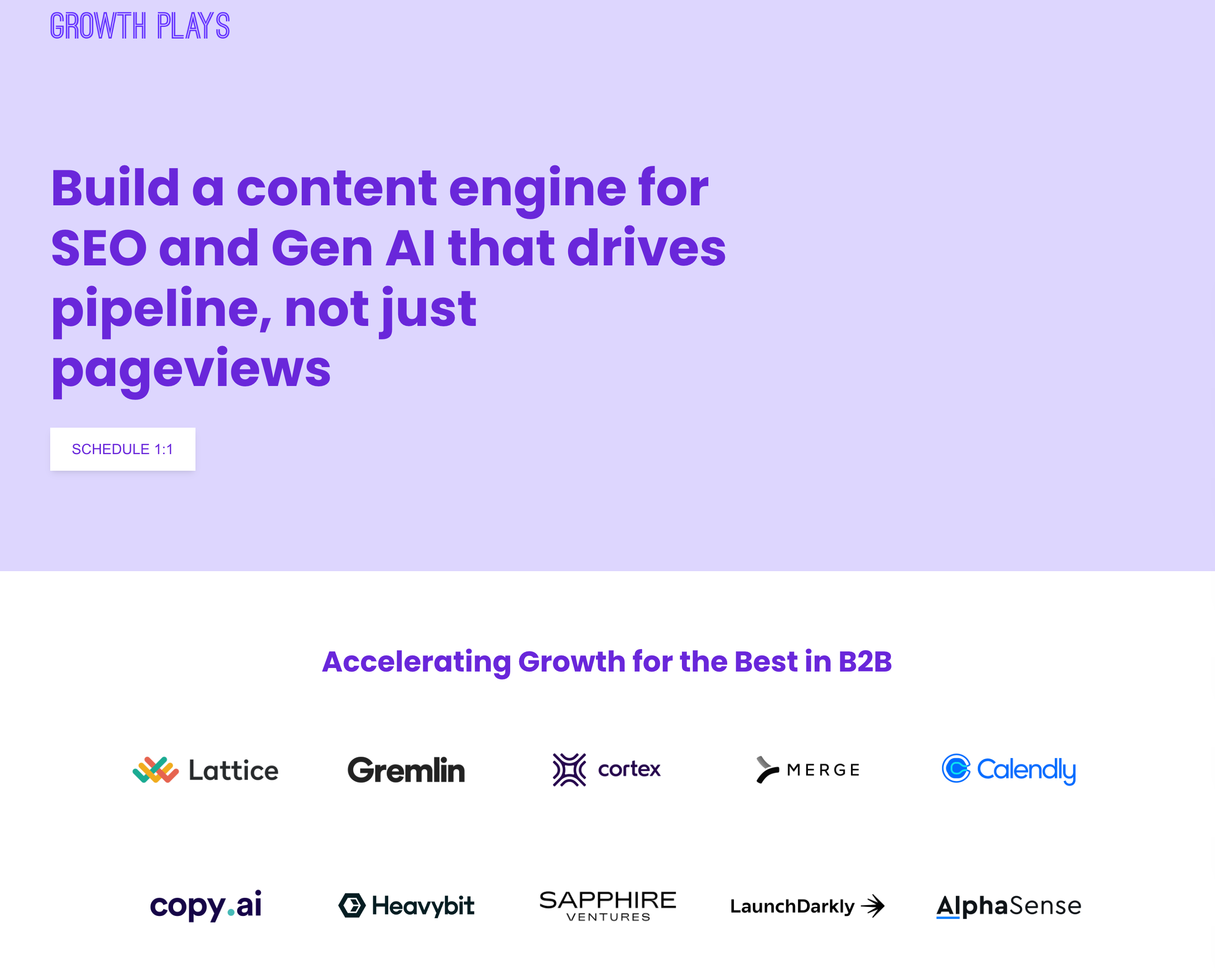
If you’re on a tight budget, you can set up your site with WordPress and use a free or low-cost template (there are thousands available). You’ll also find plenty of YouTube tutorials like this one to walk you through the process
But if you have some budget, consider hiring a designer to build on platforms like Webflow, Framer, or Squarespace. These can give you a more stylish look, though they can be more complicated to set up.
Here’s what to include on your starter agency website:
- A clear headline that states your value proposition, e.g., “Web design for B2B SaaS companies.”
- About/bio section with your background, credentials, and any social proof.
- Services overview that emphasizes outcomes, e.g., “Web design that reduces churn and increases signups for B2B SaaS.”
- Portfolio pieces. If you don’t have past clients yet, showcase a personal project or work you did at a previous job.
- Testimonials from past clients. But if you don’t have any, ask past colleagues or bosses for recommendations.
- Contact form with fields for name, email, message, and how they found you.
Remember, your website is a living asset. You can (and should) refine your branding and design as you grow. But in the beginning, done is better than perfect. Having a decent site up quickly will allow you to look professional when networking and pitching.
Step 6: Start cold outreach
If you didn’t freelance or consult before starting your agency, you’ll need to go out and get your first customers. There are two ways to do that: direct and indirect methods, and you need both.
The direct method is to reach out to people—both your existing network and strangers. Your warm connections are often the easiest source of early clients because they already know and trust you and are usually happy to hire or refer you to someone in their network. So, send emails or DMs to former colleagues, bosses, industry friends, and even classmates informing them of your agency and the services you offer. You can also announce your business and availability on LinkedIn, Instagram, or X to reach even more people.
But your network and referrals alone won’t carry you forever. It might get you to $1M, maybe $5M, but you’ll eventually plateau unless you build a go-to-market engine that consistently turns strangers into clients. That’s where cold outreach comes in. It takes effort, but when done well, it helps you connect directly with your ideal clients and start sales conversations.
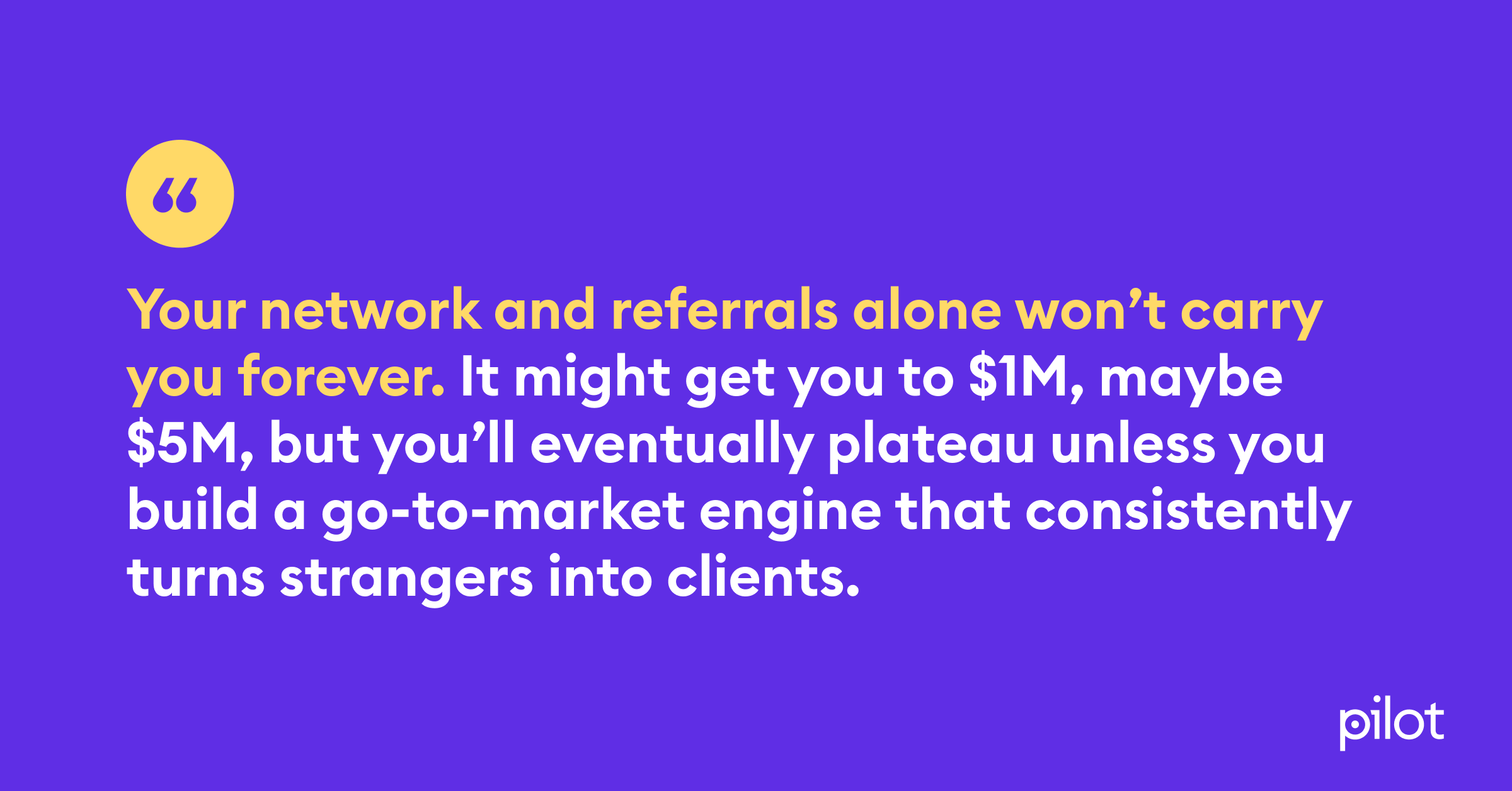
To get started, search LinkedIn or Crunchbase for 30-50 companies in your niche that could benefit from your services—ideally, those that recently raised funding—and add them to a spreadsheet or customer relationship management (CRM) tool like HubSpot.
Then find decision-makers for each company on LinkedIn. This is usually the CEO, founder, or marketing head. Get the emails of these decision-makers using Hunter.io or Apollo.io.
Next, send a short personalized pitch that identifies a problem they’re facing, and shares how you’ve solved such problems for similar companies in the past and can help them too. Make sure to focus on them and their needs, not you.
Conclude the email by asking them if they’re open to a quick 15-minute call to discuss further. Make sure to follow up 2-5 times at 3-7 day intervals. Most people don’t respond to the first email, so this is important.
Pro-tip: Track who you contact, when, and how they respond in your CRM or spreadsheet. Staying organized helps you follow up at the right time and avoid pitching the same person twice.
Step 7: Build your founder brand
The indirect method of getting clients is to build a founder brand. As they say, “Marketing is asking them out. Brand is why they say yes.” If you can help people know you before you meet, this is one of the most cost effective ways to market. It’s working while you sleep. It also makes buyers more likely to say “Yes”, often without you having to sell too hard.
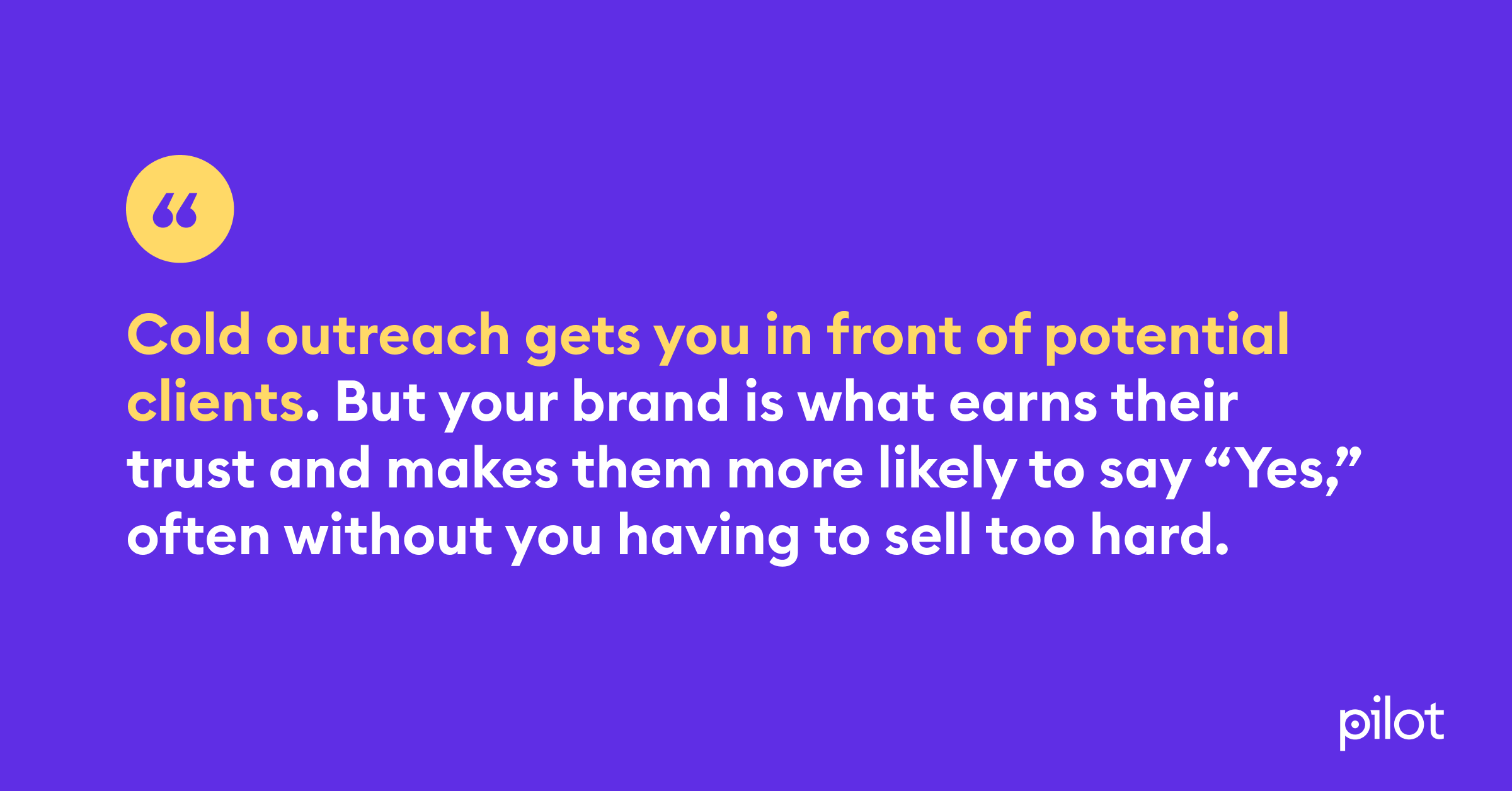
That’s been true for Mariya Delano, founder of creative agency, Kalyna Marketing. She went from losing deals to more visible agency owners to hardly ever competing anymore.
“We very rarely compete with anybody for projects. Most of the time, it’s just whether they want to work with us or not. People say it’s because they trust me—I’ve convinced them of something,” Mariya says.
Her visibility online is also how she was able to 10x her rates in just a couple of years. Your personal brand gives people a reason to want to work with you, even before you pitch. It keeps you top of mind, builds credibility, and attracts better-fit clients who already believe in your expertise.
How do you build your founder brand? Start by sharing your ideas, lessons, and experiences on LinkedIn, Instagram, X, or other platforms where your target market hangs out. Don’t be afraid to share bold or controversial takes—that’s what will make people engage with your posts.
“I think a lot of people are playing it safe because they have no courage to be disliked. You have to be okay with being disliked; otherwise, you’re going to sound like everybody else on the internet,” says Ross Simmonds, founder of Foundation Marketing.
Use the 70-20-10 rule to guide what you post:
- 70% Educational: Share what you’re learning and insights on your niche.
- 20% Practical: Post checklists or templates that will help your target audience.
- 10% Promotional: Highlight wins and invite people to book a call.
This mix is what Tyler Hakes, founder of Optimist uses, and it’s how he used it to build a founder brand on LinkedIn that led to an inbound deal worth $500k/year for his agency.
Beyond social platforms, join communities where your ideal clients or peers gather. For marketing agencies, some communities you can join include Superpath or Exit Five. Don’t pitch, be helpful. Answer questions, share what’s worked for you, and contribute meaningfully. Over time, you’ll build a reputation and earn referrals.
Founder branding takes time; that’s why we said it’s the indirect method. You won’t start posting today and get clients tomorrow. But the effort compounds. Months or even years later, people will remember what you shared and reach out when they need help, like they do for Alex Birkett, co-founder of Omniscient Digital.
“I’ve had people reach out who read my content back in 2015. People I met at conferences years ago, folks who knew me from my CXL days, or ex-colleagues who now lead other companies—they’ve all helped us in ways I couldn’t have predicted,” says Alex.
Step 8: Create operating procedures early
When you’re scrambling to get initial clients and deliver work, creating standard operating procedures (SOPs) might not seem urgent. But investing a bit of time early on to document how you do things can pay off as you grow.
SOPs are basically step-by-step checklists or guidelines for recurring tasks in your business like onboarding clients, delivering work, preparing invoices, hiring, etc. Documenting these processes will save you time, reduce errors, and make it far easier to delegate or outsource work later.
For example, you could have a simple checklist for “New client onboarding” that lists every step from contract signing, to setting up a Google Drive folder to scheduling a kickoff call, etc. That way, you don’t miss any step, and when you hire help, you can hand them the checklist to follow.
Creating SOPs and building internal systems changed everything for Beam, a content marketing agency.
When co-founder Rebecca Nash began managing operations, the team managed projects using Google Docs and Sheets, but there was a lot of confusion with that method. Team members lost track of client requests, missed deadlines, and didn’t have a clear sense of what had been completed or what still needed to be done.
To fix this, Rebecca moved their operations into ClickUp and began documenting SOPs for each recurring task. She created templates for common workflows like onboarding clients, onboarding employees, and evaluating new leads, and added task assignments, due dates, and comment threads to track communication.
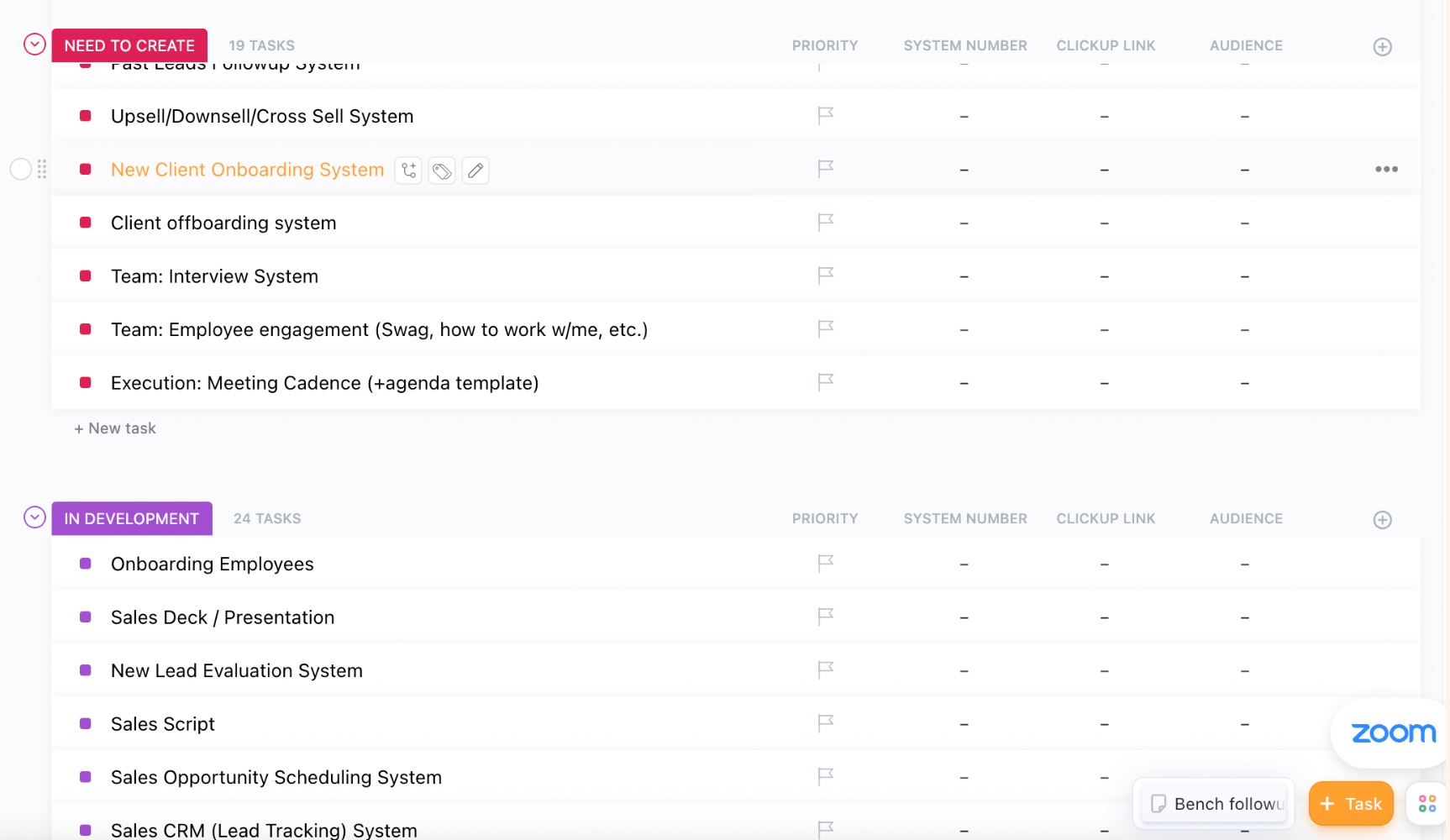
Each project now follows a structured workflow with clear steps and responsibilities. This shift helped the team stay aligned, reduce delays, and avoid rework. It also gave Rebecca visibility into how projects were progressing and whether team members were following processes correctly.
Creating SOPs for every process might feel overwhelming, but you don’t have to do it all at once. Spend 2–3 hours each week documenting one process or workflow you already follow. Use a tool like Notion, ClickUp, or Monday to organize them.
These SOPs don’t need to be long or complex. A simple numbered list or bullet points for each step is enough. If you’re stuck, start with a built-in template from these tools and customize it for your agency.
Save each SOP in your project management tool and in Google Drive so you and your team can access them easily later.
For instance, here are some of the templates on Notion for “client onboarding for agencies”:
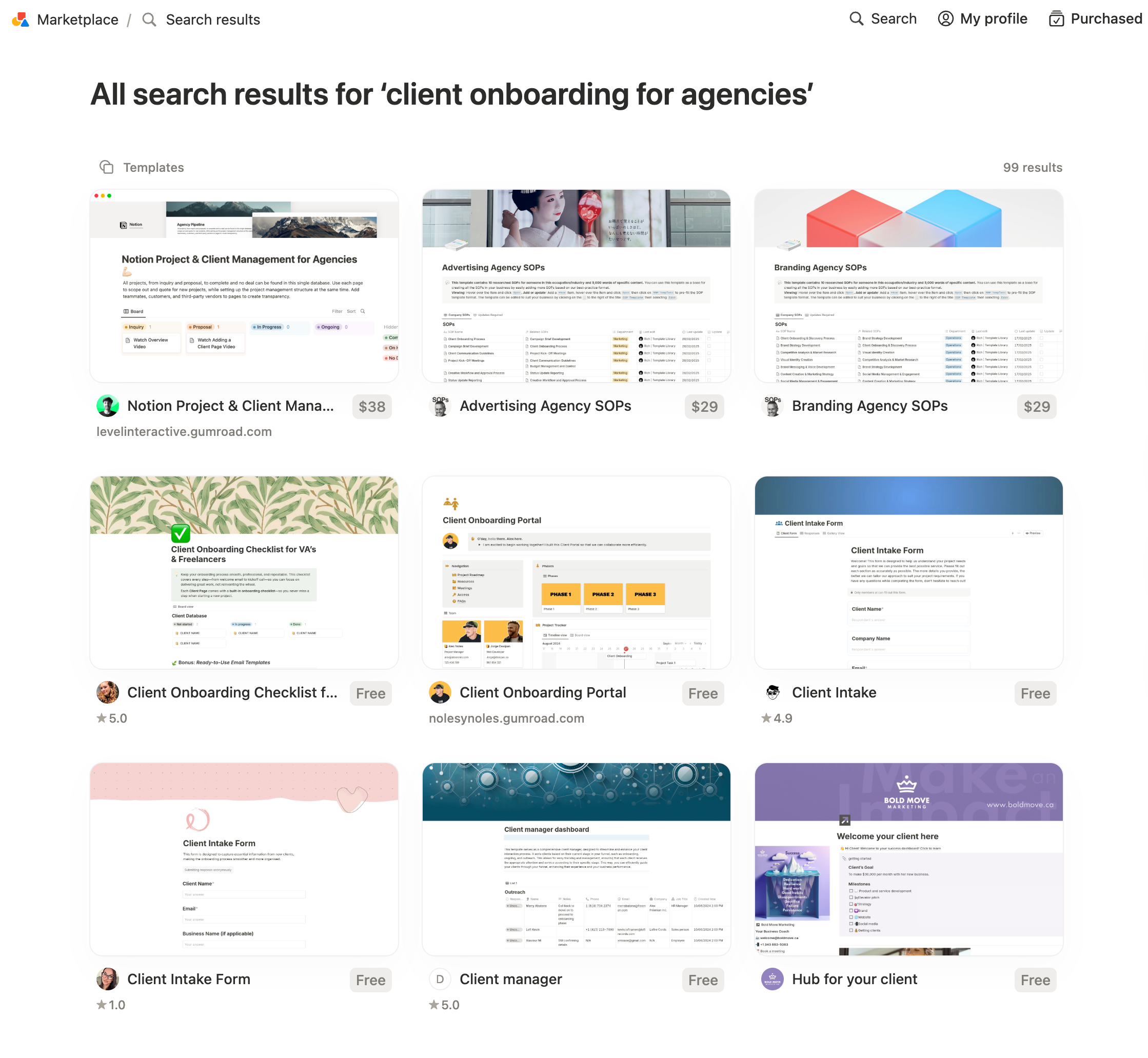
Pro tip: SOPs are living documents. Update them whenever you find a better way of working. And make sure people actually follow them. Use them yourself, explain why they matter, and make it easy to find and use.
“It’s not just about having clear systems,” Rebecca says. “It’s about having someone who maintains those systems and makes sure people use them well. If your team isn’t following good project management habits, the system doesn’t matter.
Step 9: Hire slowly—start with trusted contractors
As your agency takes on more work, it’s tempting to hire full-time employees right away. But rushing to hire, especially based on a few big wins or projected growth, can leave you overstaffed and struggling during slow periods.
A better approach is to stay lean and flexible. Start with freelancers or contractors to handle overflow work, then only convert roles to full-time when you have sustained demand.
Hiring full-time employees doesn’t only cost you their basic salary. You also have payroll taxes, benefits, legal compliance, and management overhead, making employees more expensive than contractors. Wages and salaries accounted for 70.2% of employer costs, while benefit costs accounted for the remaining 29.8% according to the U.S. Bureau of Labor Statistics. Many new agency owners don’t consider this added cost and end up with bloated payrolls that hurt profitability.

Take Barbara Stephenson of 300FeetOut. Even though her digital marketing agency sometimes provides writing services, she doesn’t employ a full-time writer. Demand fluctuates, and because they serve multiple industries, one writer can’t cover them all. Instead, she uses freelancers and agencies for support when needed.
Todd Nienkerk of Four Kitchens also learned the hard way not to hire aspirationally. In the past, his agency hired full-timers assuming more work would follow, but when it didn’t, they were forced to downsize. Worse, they waited too long, which made the cuts even more painful.
“Most agencies wait too long to let people go. And the longer you wait, the worse it gets. You often have to let even more people go.” Todd says. His rule now? Don’t hire unless it’s a sustained, permanent need.
So when should you hire full-time?
- When you’re consistently hitting revenue levels that support another salary.
- You can utilize 80% of the person’s time and efforts.
- Hiring will save you money or time to make more money.
- You can cover the full cost and still maintain at least 20% profit margin.
Agency owner John-Henry recommends ensuring revenue growth outpaces headcount growth. “Aim to not grow headcount as fast as you grow revenue. Your revenue growth should accelerate beyond headcount growth, so you’re growing more and more profitable,” he says.
Some practical tips:
- Keep a vetted freelancer roster with skills, rates, and notes in your project management tool.
- Treat freelancers well. Pay on time, communicate clearly, and check in quarterly.
- When hiring full-time, consider your freelancers first. They know your systems and clients.
Step 10: Get fractional finance and operations help
Many new agency founders assume they don’t need a CFO or COO until they’ve grown much bigger, and they try to handle everything themselves. But waiting too long to bring in financial and operational support can lead to costly mistakes. In the early days, you’re juggling sales, client work, and admin, but often neglect the back office.
Bringing in experienced professionals early, even on a part-time or fractional basis, takes pressure off you and sets a strong foundation for growth.
“A founder is not a business owner. A founder has an idea and the drive to push it. But you need other people to run the business. As soon as you get big enough to hire for other positions, do so,” Barbara says.
Here are three areas where fractional help makes the biggest difference:
Fractional CFO: Even a few hours a month of professional finance guidance can help you set up financial systems, forecast cash flow, establish revenue/expense targets, and price services profitably. A CFO can also advise on tax structures and help you understand your margins and runway.
Fractional COO or operations expert: They can set up your project management tool, document your SOPs, create onboarding processes for clients or freelancers, implement contracts, proposals, and other workflows.
Bookkeeper: A bookkeeper keeps your books clean. They ensure your income and expenses are accurate, so you always know your runway and profitability, and keep you compliant with the IRS.
The bottom line is you don’t have to (and shouldn’t) do everything yourself. Fractional support is scalable—you can start with a few hours a month, increase as needed, or pause during slower times.
That’s where Pilot comes in. Pilot acts as a one-stop launchpad for agencies and startups, offering:
- Clean bookkeeping and reporting from day one, so you always know where your business stands.
- Cash flow forecasting so you know when it’s safe to hire or invest.
- Pricing and contract guidance to protect margins and avoid undercharging.
- Tax filings and compliance so you don’t miss deadlines or face penalties.
- A fractional CFO who builds your financial model and meets monthly to guide your growth.
With this, you get enterprise-level finance, accounting, and operations support without the full-time cost. It's the kind of foundation that helps agencies scale sustainably.
Play the long game to build a long-lasting agency
Every founder’s path is different. Some land clients quickly, while others take longer to build momentum. But the common thread in nearly every success story is consistency and perseverance. The founders we’ve highlighted made mistakes, but they kept learning from them and improving instead of quitting.
Keep marketing yourself, improving your skills, and delivering great work. That’s how you build a reputation that brings in steady business. Above all, you need grit. There will be slow months and setbacks that feel like the end, but they usually aren’t. Push through, adjust where needed, and stay focused.
By following the steps in this guide, you’re not just learning how to start an agency; you’ll build one that lasts for decades.



.png)
.jpg)
.jpg)